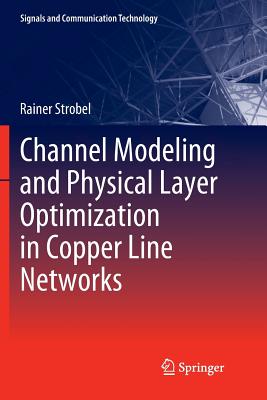This book investigates the physical layer aspects of high-speed transmission on twisted-pair copper wires, where the most performance-critical components are multi-input multi-output (MIMO) precoding and multi-line spectrum optimization as well as optimized scheduling of the transmission time slots on the fiber to the distribution point (FTTdp) copper link. The book brings theoretical results into the implementation, which requires the introduction of realistic channel models and more practical implementation constraints as found in the copper access network. A good understanding of the transmission medium, twisted-pair telephone cable bundles is the basis for this work. Starting from the analysis of measurement data from twisted-pair cable bundles at high frequencies, it presents a MIMO channel model for the FTTdp network, which allows the characteristic effects of high-frequency transmission on copper cable bundles in simulation to be reproduced and the physical layer transmission methods on the copper channels to be analyzed and optimize. The book also presents precoding optimization for more general power constraints and implementation constraints. The maximization of data rate in a transmission system such as G.fast or VDSL is a combinatorial problem, as the rate is a discrete function of the number of modulated bits. Applying convex optimization methods to the problem offers an efficient and effective solution approach that is proven to operate close to the capacity of the FTTdp channel. In addition to higher data rates, low power consumption is another important aspect of the FTTdp network, as it requires many access nodes that are supplied with power from the subscriber side over the twisted- pair copper wires. Discontinuous operation is a method of quickly adding and removing lines from the precoding group. To implement this, the system switches between different link configurations over time at a high frequency. The transmission times of all lines are jointly optimized with respect to the current rate requirements. Discontinuous operation is used to save power, but also makes it possible to further increase the data rates, taking the current subscriber traffic requirements into account. These methods are compared with theoretical upper bounds, using realistic channel models and conditions of a system implementation. The performance analysis provides deeper insights into implementation complexity trade-offs and the resulting gap to channel capacity.
This book investigates the physical layer aspects of high-speed transmission on twisted-pair copper wires, where the most performance-critical components are multi-input multi-output (MIMO) precoding and multi-line spectrum optimization as well as optimized scheduling of the transmission time slots on the fiber to the distribution point (FTTdp) copper link. The book brings theoretical results into the implementation, which requires the introduction of realistic channel models and more practical implementation constraints as found in the copper access network.
A good understanding of the transmission medium, twisted-pair telephone cable bundles is the basis for this work. Starting from the analysis of measurement data from twisted-pair cable bundles at high frequencies, it presents a MIMO channel model for the FTTdp network, which allows the characteristic effects of high-frequency transmission on copper cable bundles in simulation to be reproduced and the physical layer transmission methods on the copper channels to be analyzed and optimize.
The book also presents precoding optimization for more general power constraints and implementation constraints. The maximization of data rate in a transmission system such as G.fast or VDSL is a combinatorial problem, as the rate is a discrete function of the number of modulated bits. Applying convex optimization methods to the problem offers an efficient and effective solution approach that is proven to operate close to the capacity of the FTTdp channel.
In addition to higher data rates, low power consumption is another important aspect of the FTTdp network, as it requires many access nodes that are supplied with power from the subscriber side over the twisted- pair copper wires. Discontinuous operation is a method of quickly adding and removing lines from the precoding group. To implement this, the system switches between different link configurations over time at a high frequency. The transmission times of all lines are jointly optimized with respect to the current rate requirements. Discontinuous operation is used to save power, but also makes it possible to further increase the data rates, taking the current subscriber traffic requirements into account. These methods are compared with theoretical upper bounds, using realistic channel models and conditions of a system implementation. The performance analysis provides deeper insights into implementation complexity trade-offs and the resulting gap to channel capacity.
Get Channel Modeling and Physical Layer Optimization in Copper Line Networks by at the best price and quality guranteed only at Werezi Africa largest book ecommerce store. The book was published by Springer Nature Switzerland AG and it has pages. Enjoy Shopping Best Offers & Deals on books Online from Werezi - Receive at your doorstep - Fast Delivery - Secure mode of Payment
 Jacket, Women
Jacket, Women
 Woolend Jacket
Woolend Jacket
 Western denim
Western denim
 Mini Dresss
Mini Dresss
 Jacket, Women
Jacket, Women
 Woolend Jacket
Woolend Jacket
 Western denim
Western denim
 Mini Dresss
Mini Dresss
 Jacket, Women
Jacket, Women
 Woolend Jacket
Woolend Jacket
 Western denim
Western denim
 Mini Dresss
Mini Dresss
 Jacket, Women
Jacket, Women
 Woolend Jacket
Woolend Jacket
 Western denim
Western denim
 Mini Dresss
Mini Dresss
 Jacket, Women
Jacket, Women
 Woolend Jacket
Woolend Jacket
 Western denim
Western denim
 Mini Dresss
Mini Dresss





































